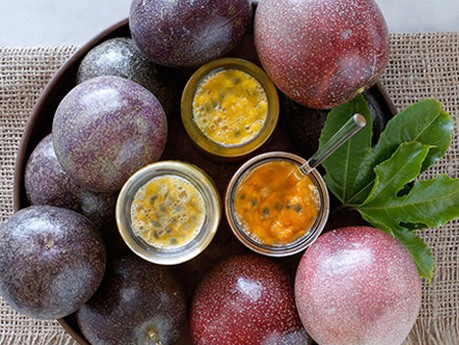Passionfruit Australia says summer production is back to normal thanks to some rain and kinder weather conditions, after seriously dry weather was detrimental to the winter production this year.
President Tina McPherson says production has varied across the growing regions.
"In northern NSW and Sunshine Coast regions, passionfruit harvest is running about 4-6 weeks behind normal production due to a longer and cooler-than-usual spring," she said. "Some farms in NSW reported the first flowering as late as October. Fruit from those regions have just started to flow in significant quantities, so there is ample passionfruit to continue the pre-Christmas demand of the fruit."

Photo: Different passionfruit varieties (Passionfruit Australia/Hort Innovation)
Ms McPherson is one of the country’s largest passionfruit growers. Her and her husband Bruce produce over 150 tonnes of passionfruit a year from their farm in Bundaberg. She says the overall industry numbers are looking slightly lower than normal.
"Volumes have been down early in the summer, which is unusual, she said. "Normally we would expect a peak in production before Christmas. Although this year, many of the growing regions are experiencing the flush 4-6 weeks later than usual. This means that there is plenty of juicy, plump passionfruit in stores now, when there is traditionally less available."
The peak industry body says last winter’s production was extremely low in the Bundaberg region for Misty Gem passionfruit due to incredibly dry conditions and low pollination.
"Fortunately, in this region passionfruit production was on target for the summer and growers experienced good production with reasonable prices through December," she said. "In the Sunshine Coast region, volume this winter was very steady, and production continued for a longer period than usual, without an extreme peak to the supply."

Photo: The Sweetheart variety (Source: Passionfruit Australia/Hort Innovation)
However, a major positive for the industry is that the Australian appetite for passionfruit continues to grow.
"This has been assisted by a structured marketing campaign managed by the industry and Hort Innovation, which has kept passionfruit in buyer focus and has ensured ongoing consumption," Ms McPherson said. "Available data shows that 1 in 5 households currently buy passionfruit each year, giving the industry a large opportunity to bring in new consumers. Activities like sampling the fresh fruit to give people the chance to experience the unique flavour and a continued strong presence on social media providing inspiration for how to finish a dish with passionfruit, will continue to drive demand."
Passionfruit has two peaks in summer and winter, and fruit is usually available year-round from one or the other region. February and November usually see supplies at their lowest with prices climbing in line with the reduction in supply.
"Each region has fruit flushes at slightly different times," Ms McPherson said. "North Queensland production starts around August and then production moves south through Central Queensland, Wide Bay and Bundaberg, Sunshine Coast and then Northern NSW. As passionfruit is rather fickle in its growing demands, slight changes in temperature, and weather can seriously affect the production in a region or on a particular farm."

For more information visit:
www.aussiepassionfruit.com.au
